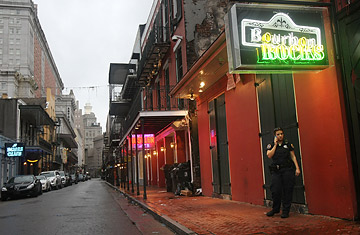
A police officer patrols the French Quarter in the aftermath of Hurricane Gustav
Hurricane Gustav failed to live up to its hype in New Orleans. But it succeeded at reminding the world that New Orleans remains a city very much in crisis. Now, the city must figure out where to go from here.
Mayor C. Ray Nagin said late Monday that employees of certain key businesses and institutions would be allowed to return to the city as soon as today to begin preparing for returning evacuees. Among the essential details that must be dealt with: replenishing meat and vegetable supplies at supermarkets, as well as fuel at the region's gasoline stations. Gustav prompted the largest evacuation in the state's history. Now, many fear a repeat of the headache-inducing "contra flow" — the technocratic term that refers to both lanes of roads and highways being used to direct traffic in the same direction.
But Polly Watts will be spared that ordeal. That's partly because the 43-year-old remained in the city through Hurricane Katrina and learned lessons in getting back on her feet quickly. Despite the unrest that followed Katrina, she was able to quickly fix up her bar, the Avenue Pub, which sits on St. Charles Avenue. And so Watts chose to remain for Gustav as well. "Being here immediately after the damage is done gives you the ability to make temporary repairs," she says. "Had we evacuated, it might have taken us a month to get back into the city." She adds, "It's not a question of when you want to come back — it's a question of when the city allows you back in."
The Avenue Pub was one of the few places in the city serving beer and burgers — or any meal — on Monday night as New Orleans bade goodbye to Gustav. So naturally it was a hot spot for Uptown residents (many of whom remained in the city because their neighborhood rarely floods). One tended the bar. Another set up generators to provide a bit of light, since Gustav's winds had knocked out electricity. Watts pointed to yet another band of protection: two New Orleans police officers sitting at the tip of the bar, drawn partly by the free meals that the Avenue offers law-enforcement officials. "It keeps them close," she says. Their presence certainly deters would-be looters. Indeed, fear of looting remains a concern. Many parishes imposed aggressive dusk-till-dawn curfews. As for the fear of levee breaches, nothing significant occurred. "So far so good," said FEMA spokesman Ed Conley.
While New Orleans felt relieved, Baton Rouge was surprised. The state capital appeared to get the brunt of Hurricane Gustav after it made landfall Monday morning. New Orleans was hit hard early Monday as Gustav came ashore west of New Orleans over Terrebonne parish. By midday, however, the storm had taken a northwestern turn, which brought it closer to Baton Rouge than was predicted. Winds were gusting at more than 70 m.p.h. in the metro Baton Rouge area, where top local, state and federal officials — including Louisiana governor Bobby Jindal, Senator David Vitter and Homeland Security Secretary Michael Chertoff — were hunkered down to monitor the storm.
Baton Rouge was hammered with wind and rain for about three hours. Electrical power flashed on and off for about an hour before it went out for good. In the area near Louisiana State University, the hurricane-force winds blew down trees, fences, power lines and street signs. Some streets had minor flooding. Driving was still treacherous on Monday afternoon with huge tree trunks blocking roadways and traffic lights not functioning. One of the major Baton Rouge hospitals, Our Lady of Lake, had to operate on generator power. "Please stay indoors and please don't be on the road if you don't need to be," Jindal warned residents during an early afternoon news briefing. By evening, power had not yet been restored to much of the city. On Tuesday, Jindal said about 1.4 million households in the state remain without electricity.
